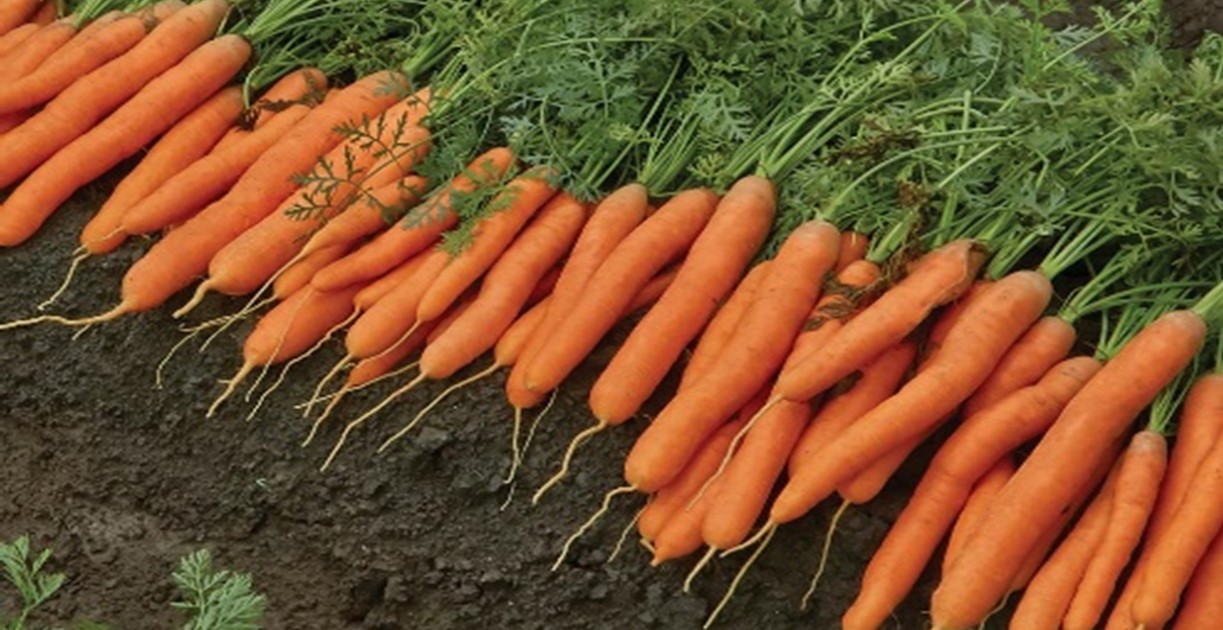
1. BACKGROUND
Distribution
Production of carrot (Daucus carota) in Limpopo Province is relatively low compared to other provinces in South Africa., though the production takes place in all five districts of the province.
Soil and Climatic Requirements
Deep, loose, friable, well-drained sandy loam or loamy soils with a pH of 6,0 to 6,5 are ideal for carrot production due to their sensitivity to saline soils. Heavy, stony, compacted and poorly drained soil interferes with the development of the roots. The saline and acid soils below pH of 5 should be avoided when producing carrot. Optimum temperature for production is between 15 °C to 20 °C. Temperatures below 10 °C causes longer, slenderer, and paler roots and shorter, thicker roots are produced at higher temperatures. Extended periods of hot weather can cause strong flavour and coarse roots.
2. CULTURAL PRACTICES
Planting
Soil should thoroughly prepared, with a level, fine, soil surface and loosen to a depth of at least 30 cm to allow good root development. The rows are generally spaced from 20 to 40 cm apart. In double or triple rows, the width between sets of rows may range from 40 to 60 cm. Row spacings in baby carrot production may be 10 cm. A recommended planting density of 150 to 160 plants m2 gives good results in double rows while a density of 100 plants m2 is ideal for single rows with the in-row spacing of about 5 cm.
The seeds are directly sown in the field on ridges or raised beds. Row planting is preferred compared to broadcast sowing. Planting depth is between 0.5 cm and 1.5 cm. Planting date varies, cold areas (heavy frosts) is January to March and August to December in warm areas (light frosts) is January to November and hot areas (no frost) February to September.
Fertilization
It is always recommended that a soil and water analysis be done prior to planting carrots. This will ensure that all factors, including pH are considered thereby reducing fertiliser waste and eliminating the risk of over-supply and possible risk of fertiliser burn of the crop.
Fertiliser guideline
Carrots have low Nitrogen requirements and good yields can be obtained with applications of 80 kg ha-1. Nitrogen can be applied at planting and the remainder at 4 to 8 weeks post planting. Phosphorus can be applied at 40 kg ha-1 is sufficient to produce a good crop. The crop has a high Potassium requirement and half is applied as side dressing at 4 to 8 weeks after planting. The balance is applied as late dressings. Compost or organic manure should not be applied because it results in unattractive, hairy roots, with a coarser texture.
Irrigation
The soil should never be allowed to dry out. Too much moisture causes short carrots with a light colour and a larger diameter. The field should be irrigated lightly immediately after sowing. Irrigation water should be applied once or twice a day, using a solid-set sprinkler system. Watering should be reduced gradually to prevent longitudinal splitting of the roots when the crop approaches maturity.
Pest and disease control
Pests that frequently affect carrots include aphids, red spider mites and cutworms. Remedies for such pests can include applying registered pesticides. Practising crop rotation is critical. Weeds that serve as the hosts plants to these pests must be removed.
3. CULTIVAR SELECTION
When selecting carrot cultivars, consider market (who is your client), yield potential, root shape and size, colour, flavour, disease resistance, and adaptability to your specific growing conditions.
Cultivars
- Imperator: not a common type grown for the commercial fresh market.
- Nantes: commonly used for home or farmer market or roadside stands, although is mainly grown for commercial fresh market.
- Amsterdam or Miniature: this is considered the true "baby carrot" which are mostly used for the cello bag and for processed mixed vegetable packs.
Sources
- A Profile of the South African Carrot Market Value Chain 2021
- Department of Agriculture, Forestry and Fisheries, 2010
- Starke Ayres: Carrot Production Guideline, 2014

